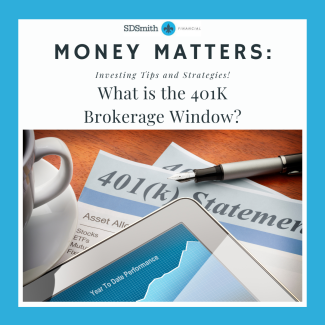
What is the 401K Brokerage Window?
When you log in to check your 401(k) balance, you might notice an option labeled “Brokerage Window” or “Self-Directed Brokerage Account” (SDBA). But what exactly is this, and how can it impact your financial strategy? More importantly, could it be a valuable tool for enhancing your retirement planning? Let's explore what an SDBA is, how it works, and whether it might benefit your financial future.
What Is an SDBA?
A Self-Directed Brokerage Account (SDBA) within your 401(k) plan gives you the flexibility to invest beyond the limited options typically offered by standard 401(k) plans. Instead of sticking to preset choices like target-date funds or index funds, an SDBA allows you to invest in a broader range of assets, including ETFs, mutual funds, and individual stocks and bonds. This can be particularly useful if you want to tailor your investments more closely to your personal financial goals.
The Benefits of Using an SDBA
-
Enhanced Investment Choices: Traditional 401(k) plans often limit you to a small selection of investment options. With an SDBA, you have the freedom to diversify your portfolio more extensively and align it with your long-term financial strategy.
-
Potential for Higher Returns: By selecting investments that suit your risk tolerance and objectives, you might achieve better returns compared to sticking with the standard options. For example, if your SDBA investments outperform your plan’s default options by just 3% annually, you could reach your retirement savings goals significantly sooner.
-
Maintained Tax Benefits: Investing through an SDBA still allows you to enjoy the tax advantages of a 401(k), such as tax-deferred growth on your investments.
The Drawbacks to Consider
-
Higher Costs: Investments within an SDBA can be more expensive than those offered directly through your 401(k) plan. Be mindful of potential fees and expenses that could eat into your returns.
-
Increased Risk: Greater investment freedom also comes with increased responsibility. If you choose high-risk investments or poorly diversify your portfolio, you could face substantial losses. It’s crucial to understand the risks associated with each investment and ensure your choices align with your risk tolerance.
-
Complexity and Management: Managing an SDBA requires more time and knowledge. You’ll need to actively monitor and adjust your investments, which can be complex compared to a more hands-off 401(k) option.
A Case Study: The Impact of SDBA Performance
Let’s consider Tom, who has $250,000 in his 401(k) at age 43 and plans to retire at 65. Currently, Tom contributes $10,000 annually, with an additional $5,000 from his company. Assuming a 7% annual return, Tom would have about $1.9 million by retirement. However, if his SDBA investments yield an average annual return of 9%, Tom could potentially retire 5 years earlier, at age 60. This scenario demonstrates how an SDBA could accelerate your retirement timeline if managed effectively.
On the flip side, poor performance in an SDBA could delay your retirement and negatively impact your financial security. It’s essential to carefully assess your risk tolerance and investment strategy.
Getting Started
If you're intrigued by the possibility of an SDBA, check with your benefits plan provider to see if this option is available to you. You can also reach out to a financial advisor for personalized guidance and to ensure that your investment choices align with your overall financial goals. If you need assistance or have questions about your plan’s benefits summary, feel free to contact me or schedule a call below.

